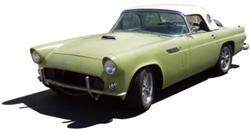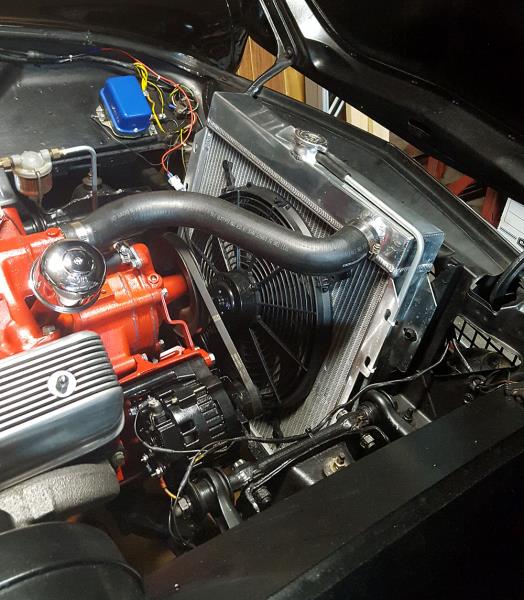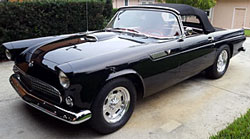|
Author
|
Message
|
|
GREENBIRD56
|
|
|
Group: Forum Members
Last Active: Last Year
Posts: 1.7K,
Visits: 102.7K
|
I understand the thoughts Melly has about the increase to four fan blades. When I got my bird (from an owner who had bought it used in 57) - it had a four blade and a three blade was in the trunk. When I went to a local gathering of birds at the annual "Cops and Rodders" show, I looked around carefully to see what the locals were doing about the typical 105º here in Tucson. That group told me the four blade was a Ford "fix" of the bygone era when these cars (the little birds) were relatively new. I think all agreed - it didn't work. All were thinking that the guy from Green Valley - that had a re-cored radiator - had done the best mod. At this point I would have to agree. I've made changes for the better in mine, but in the end the ability of the small original radiator to deal with high ambients - and stop'n go trafffic - really pushes it. Not enough heat rejection capability.

Steve Metzger Tucson, Arizona
|
|
|
|
|
DryLakesRacer
|
|
|
Group: Forum Members
Last Active: Last Month
Posts: 1.7K,
Visits: 340.1K
|
Not having any other reason to respond one more time to the question which Melly asked but we have 3 pages and countless answers for cooling problems Melly didn’t ask and apparently doesn’t have. From his information and photo I believe the car in question is a 55 Victoria or Crown Victoria. I too am the blame. He has never responded since his first inquiry. Answer: The addition of a 4 blade from a 3 blade will help if the cooling system is in good shape by drawing more air thru the radiator core.
56 Vic, B'Ville 200 MPH Club Member, So Cal.
|
|
|
|
|
FORD DEARBORN
|
|
|
Group: Forum Members
Last Active: 3 days ago
Posts: 789,
Visits: 113.4K
|
Ted is spot on. My experience was spending countless hours digging, scraping, poking scratching at the stuff with anything I could get down in there. Including hand bent rods with hooked ends to reach the difficult areas. This was AFTER I picked up the block from where it was hot tanked and machined at a reputable shop. My engine was probably one of the worse examples as it spent it's entire life still in use until 2010, in the western desert area of the US where antifreeze was not a great concern. It was like mud turned into cement. I found it actually impossible to remove 100% but proved to be good enough as I have no overheating issues what so ever. That being said, the truck and I live in Michigan and a 64 F100 has very little air flow restrictions. I don't ever remember vehicles having overheating issues in the day.
64F100 57FAIRLANE500
|
|
|
|
|
Ted
|
|
|
Group: Administrators
Last Active: 3 hours ago
Posts: 7.5K,
Visits: 205.8K
|
1/8cavman (6/12/2022)
.........when prepping the block for new soft plugs I was using a long thin screw driver to get the water jackets clean. I got rust and SAND out. Ran the block through the hot tank again and removed a little more. Ted, any comments? Also ran across this sand thing with a friends Y-block in a later rebuild. Could this be casting sand? ........ 1\8 Cav Man You asked so here are some of my thoughts on that. Sand/dirt build up in the blocks is common but I don't think it's casting sand. This is not just a Y-Block nuance but all engines in general. I call it ‘Mud’ and it gets packed in there very tightly or hard. Most older engines in the shop for rebuild have it and it is attributed to using tap water for the cooling system. While distilled water is recommended for cooling system use, that is not a standard practice. That ‘Mud’ typically accumulates at the back of the block around the rear cylinders where the water flow is slowest and then has to transition up to the cylinder heads to make its way forward to exit the engine. That transition upwards has the solids in the coolant dropping out at that point. Because it accumulates mostly around the rear cylinders, it does add to abnormal heating of the engine at the rear of the block. Not thoroughly cleaning the block during the rebuilding process has that new engine running hotter than normal than it should. Removing it requires some serious cleaning of which manually breaking it up and digging it out is required before actually doing a wash on the block. Using a caustic tank or wash initially is not enough to remove that sludge without some initial digging first. The really bad blocks will have a quart or more of that sludge in each side.
  Lorena, Texas (South of Waco) Lorena, Texas (South of Waco)
|
|
|
|
|
Florida_Phil
|
|
|
Group: Forum Members
Last Active: 2 Years Ago
Posts: 1.2K,
Visits: 285.6K
|
As a side note, my 292 block is .060" over. I do not run a belt driven fan or a shroud. I run 100% straight green antifreeze with no other additives. I do not have air conditioning. My electric fan runs all the time. I turn it off in the winter or my engine does not run hot enough. My engine was rebuilt about 3,000 miles ago. I run a stock 1957 Ford distributor with a Pertronix unit and coil. My timing is 36 degrees total. 

|
|
|
|
|
1/8cavman
|
|
|
Group: Forum Members
Last Active: Last Year
Posts: 23,
Visits: 40.2K
|
All the preceding info is great and mostly correct. My 50 cents worth. Volumes have been written about T-bird overheating. I have owned my 56 Bird since 1970. It was my only car and a daily driver. The daily driver didn't last because of living on the Oregon coast with lots of rain. I knew it would leak into the interior, but raining sideways was like no top. Shortly after buying it I had some over heating problems. So a total rebuild was in order. This was done under very experienced eye of a Ford mechanic. He warned me not to bore it .060 over but it is still going strong at over 50000 miles. Balanced, three angle valve seats and amateur porting, 600 cfm Holley, has ran great. All this said when prepping the block for new soft plugs I was using a long thin screw driver to get the water jackets clean. I got rust and SAND out. Ran the block through the hot tank again and removed a little more. Ted, any comments? Also ran across this sand thing with a friends Y-block in a later rebuild. Could this be casting sand? A 6 blade fan from a 406 FE, large hole t-stat, Champion aluminum radiator has made this engine run very well in stop and go heat. Only time it got a little warm was in a very slow stop and go cruise up hill in 95 to 100+ heat. Pop the hood to let heat out and rev the engine kept it below 190 degrees. No other problems. Getting the HOT air out the engine compartment when moving slow would help a lot. The improved spacer and larger impeller water pump are real good investments. 1\8 Cav Man
|
|
|
|
|
55blacktie
|
|
|
Group: Forum Members
Last Active: Yesterday
Posts: 1.2K,
Visits: 1.8K
|
I forgot timing.LOL
|
|
|
|
|
55blacktie
|
|
|
Group: Forum Members
Last Active: Yesterday
Posts: 1.2K,
Visits: 1.8K
|
Any benefit from reducing parasitic loss by using an aftermarket fan would be a far second from having a fan that's going to keep air flowing through the radiator to reduce engine temperature. Nevertheless, if you have found the right combination for success, that's great. If Chris Ames's Paragon Industries Tbird wp spacer, Casco's HD wp and lower fan shroud, 6-blade mechanical fan, wide-mouth thermostat, smaller pulley, and 4-row copper & brass U.S. Radiator don't get the job done, I'll add an electric pusher fan between the grill and radiator. I'll also make sure that any rust/scale is removed from the block as part of the rebuild process.
The thermometer reached 105 in the Central Valley yesterday, and 101 expected today. However, my Tbird doesn't have a/c. What that means is when it's too hot for me, it's too hot for the Tbird; it will stay in the garage.
|
|
|
|
|
Florida_Phil
|
|
|
Group: Forum Members
Last Active: 2 Years Ago
Posts: 1.2K,
Visits: 285.6K
|
I doubt changing the number of fan blades is going to get you where you want to go. Here in Central Florida, the weather is hot and traffic is heavy. At a car show, you may have to wait in line with your engine running for some time. My TBird had evidence of earlier overheating "fixes". A previous owner had used a torch to smoke holes in the lower radiator valance in an attempt to increase air flow. This actually made things worse. To remedy the situation, I started with an aluminum radiator and a wide mouth thermostat. My old original radiator was in bad shape and I could not find anyone in my area to work on it. I tried many different fans and they didn't have much effect. All they did was make noise. For $200, I bought an EBay Champion aluminum radiator and an electric fan. My current setup is to remove the belt driven fan entirely and use the electric fan continuously. This was a big improvement, but I still had slight issues in the heat of summer traffic. I learned that Tbirds have a 1" spacer behind the water pump that causes water flow issues at idle speeds. I installed a Casco improved water pump with longer blades and this worked great. One of the first things you should do is install a quality water temperature gauge so you know what you are dealing with. Those dash gauges are worthless. I am currently happy with my Tbird's operating temperature. Some members have installed a smaller diameter water pump pulley to increase flow. Casco sells the correct one. I haven't tried it.

|
|
|
|
|
DANIEL TINDER
|
|
|
Group: Forum Members
Last Active: Yesterday
Posts: 1.7K,
Visits: 154.2K
|
55blacktie (6/8/2022)
My experience tells me that the more parts a component has, the more likely it will fail. Good point. It never occurred to me that a viscous clutch might fail, but then it DOES have a bearing. Also didn’t realize there might not be room for one on a passenger car motor (?). While mine (CASCO) is likely a basic model, I see there are even more complicated versions yet available (temp controlled/electronic/etc.). SOME added complications are a justifiable trade-off though (IMO). Not me, but urban Y-Block owners with automatic transmissions might agree (?)
6 VOLTS/POS. GRD. NW INDIANA
|
|
|
|